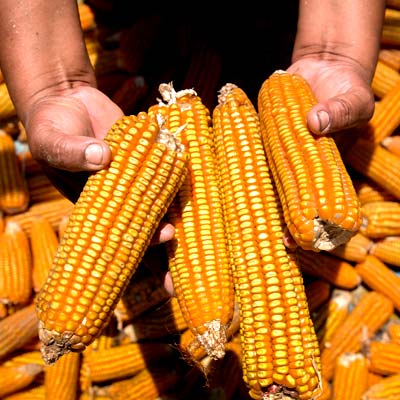By: Daniel Meza
Biotech researchers are dissatisfied with the recent extension of the moratorium on GM crops until 2035. Although some Peruvian farmers use GMOs, they were not consulted. Meanwhile, inaccurate messages are clouding a serious dialogue on the issue.
For Francisco Lalupu's family, October means the beginning of the corn harvest season. Under the scorching sun of Peru's most equatorial region, a long chain of food production begins for poultry, human consumption, commerce and the favorite drink of our ancestors, chicha de jora.
But last year was different. Thousands of miles to the south in Peru’s capital, 104 congressmen voted against the cultivation of a corn species that the 73-year-old patriarch has used for years. The representatives claimed to "defend small farmers" and "protect our biodiversity.”
The public debate was dominated by a diverse and powerful group: politicians, agricultural associations, activists and chefs. With their slogan "Peru, a GMO-free country,” they strengthened the parliamentary position to extend the moratorium -- or ban on the cultivation of genetically modified organisms (GMOs) -- for another 15 years.
A sample of the national dialogue on GMOs between 2011 and 2021 was in the Multisectoral Advisory Commission (CMA). This group (attached to MINAM) was created with the first moratorium law (29811).
Its objective was to accompany the implementation of the law, strengthen capacities and advise the State on modern biotechnology. It was made up of different sectors of the country: ministries, regional governments, universities, farmers' associations, NGOs, among others.
However, according to the testimonies of those who held technical positions in that group, progress was complicated. For Jorge Alcántara, representative of INIA, and Alberto Tenorio, former Head of the National Biotechnology Program at Concytec, anti-technology organizations prevented them from achieving their objective. They hope that the current commission, as a result of the new moratorium, will convene more scientific institutions to achieve equity.
In the regions of Lower Piura and Sechura, the Lalupu and other families grow "duck" corn. At first glance there is nothing special about it, but in 2019 the Ministry of Environment (MINAM) discovered that it had the Cry1A protein, belonging to the transgenic corn MON810, marketed as YieldGard.
Official reports said that years ago, the commercial corn was imported and planted, appealing to farmers because it was resistant to the feared corn earworm pest. Thus, it ended up being crossed with two local corn varieties.
It all happened without farmers knowing that GMOs were already in their crops.

Until the 1980s, only alazan corn was used on the northern Peruvian coast...
Until the 1980s, only alazan corn was used on the northern Peruvian coast for the preparation of chicha de jora. Later, hybrid species of hard yellow corn were introduced, such as Marginal T28, developed by the National Institute for Agrarian Innovation (INIA). To increase its productivity and obtain a corn that could be used for animal feed and also for chicha de jora, the two species were crossed. The result was so-called ‘duck’ corn (non-transgenic). Later, under circumstances that are still under discussion, came MON810 corn, which is commercialized worldwide under the name YieldGard. It was adopted by many local farmers because of its pest resistance. In the end, MON810 was eventually mixed with local species, including ‘duck’ corn.
"Now almost everything is ‘duck’ corn," Francisco told Stories without Borders (SWB) from his home in Monte Castillo, a rural village in the area.
And he was right. Although local farmers can only use certified seeds, MINAM found that in Sechura and Lower Piura they prefer 'duck' corn because it is "less pest-prone, less expensive and more resistant to the lack of water.”
Why, knowing these viewpoints, did Congress extend the moratorium until 2035? Who did it represent in this decision?
In South America, economic powerhouses -- Brazil, Argentina and Colombia -- use transgenic crops. Their agricultural economy depends heavily on them. At the other end of the spectrum is Peru, where transgenic crops are banned in the countryside.
The fight began in 2011. At that time, little was known about the impact of GMOs, so Congress decided on a first Moratorium Law for a decade, appealing to the Cartagena Protocol to "avoid irreparable damage to national biodiversity,” among other reasons.
That law mandated that the government must strengthen national capacities with respect to GMOs, create infrastructure for their release and generate baselines on biodiversity at risk.
But "we still have a big knowledge gap," former Congressman Jaime Delgado, who proposed the First Moratorium, told SWB. He also believes that "betting on transgenics is to risk our position as an exporter of organic products, regardless of whether they (GMOs) are good or bad.”
Congressman Lenin Bazán, president of the Parliamentary Commission on Indigenous Peoples, had a similar position. For this reason, he promoted the new moratorium law "in coordination with small farmers through Conveagro and renowned chefs" and also asked that "before thinking about GMOs, we should revalue our organic products.”
For its part, Conveagro, an influential group of agrarian unions that lobbied for the law, responded through its general manager Giovanna Vásquez. When asked for scientific reasons, Vásquez acknowledged that "we are a union and we can only give a political position.”
For gastronomy, businessman and chef Virgilio Martínez led a viral campaign in social media, warning between the lines that "GMOs will kill our biodiversity,” encouraging thousands to sign a petition on Change.org in favor of the moratorium. The curious strategy would not have been possible without the Agroecological Consortium, a group of organic food organizations, which together with advertisers came up with the spots.
SWB consulted Cecilia Mandiola, representative of the consortium, for evidence of the damage. Without answering the question, Mandiola referred to the campaign's success. "Peruvians identify with biodiversity and thanks to the videos we got many followers.” The impact on networks was unquestionable, as was its lack of technical support.

A sample of the national dialogue on GMOs between 2011 and 2021 was in the Multisectoral Advisory Commission (CMA)...
The moratorium “was disappointing, frustrating," said microbiologist Jorge Alcántara, director of regulation at the Institute for Agrarian Innovation (INIA).
For Alcántara, it is not a question of being for or against, but a technical position. Congress did not listen to the recommendations of INIA or the Parliamentary Commission on Science and Technology and "relied on subjectivities.”
Alcántara was struck by the anti-transgenic chefs' campaign. "As a biotechnologist, I'm not going to tell them how to make rice with ‘duck’," he quipped.
For biochemist Rosa Angélica Sánchez, professor at the Universidad Nacional Agraria La Molina and former director of Genetics and Biotechnology at INIA, the problem is ignorance. "In megadiverse countries that grow transgenics, like Brazil or the Philippines, these are not the main cause of biodiversity loss."
Recent studies revealed that such loss was due to overuse of land and resources, anthropogenic climate change, and expansion of agricultural activity, not to GMOs. Likewise, follow-up studies of GMOs for more than 15 years did not find any damage to biodiversity.
"Any contamination, whether GMO or traditional, with proper management, can be controlled," added Sánchez. For her, transgenesis could help conserve biodiversity in high Andean areas where native potatoes are disappearing due to pests.
Belgian cell biotechnologist Marc Ghislain knows a lot about pest control. For years, he has been working on creating transgenic potatoes resistant to late blight at the International Potato Center (CIP) in Lima. Today, from his home in Nairobi, Marc defines the second moratorium as "ridiculous.”
"Something that benefits farmers and the environment is being banned," he lamented.
Unable to work on the first moratorium, Marc moved to Africa, where he and his CIP team cooperate with governments. "Peruvian politicians avoid the issue because it is inconvenient," he told us.
Biologist Alberto Tenorio, who for a time was part of a commission that advised the state on GMO issues, acknowledged how difficult it was to work. "They always came back with talk of damage to biodiversity.” In addition, GMO students are opting to migrate to fields where there is less prejudice.
Was a biotechnological tool sacrificed for the sake of small farmers?
In Monte Castillo, where the Lalupu family lives, there are already enough problems to focus on in the Parliament. The government, in their regions, is conspicuous by its absence.
Despite its unwavering anti-GMO position, Conveagro acknowledged that it is not the voice of the entire national rural population. "I can only speak for the unions we represent," Vásquez acknowledged.
The presence of GMOs on the land of the Lalupu family is reflected in the rural valleys of Sechura and Bajo Piura. In a conversation with SWB, Francisco complained that they are only sought out to demand payment of loans, but do not receive agricultural training.
Farmers "are turning to GM corn because there is no better option," an agronomist who worked for the regional government in 2019 told SWB, acknowledging that "for tens of thousands of farms, there are only one or two engineers."
Is there a choice beyond black and white for such a large country? The biases are many and the subject complex, so more dialogue and evidence are needed.
To the fervent position that GMOs generate dependence on large corporations, Ghislain disagreed. "In Peru and in Africa we seek to release varieties from the public domain."
"There are hundreds of national agencies and universities developing transgenics without patents," Sanchez added.
For the experts consulted, the ideal approach would have been to allow GMOs for certain crops and not just ban them. That option, they said, would help food sovereignty. Without biotechnology, Peru’s seeds do not compete with imported ones.
When deciding on the moratorium, do the Congressmen represent the farmers, do they listen to our scientists? A clear answer would be a first step in improving the way we make decisions. It is either this, or continue depriving the country of genetic tools that, if used well, could be an important part of the solution.
The transgenic corn crops studied by the Ministry of the Environment are located in the northwestern part of Peru, in the coastal region of Piura.
Source: Ministry of the Environment Peru